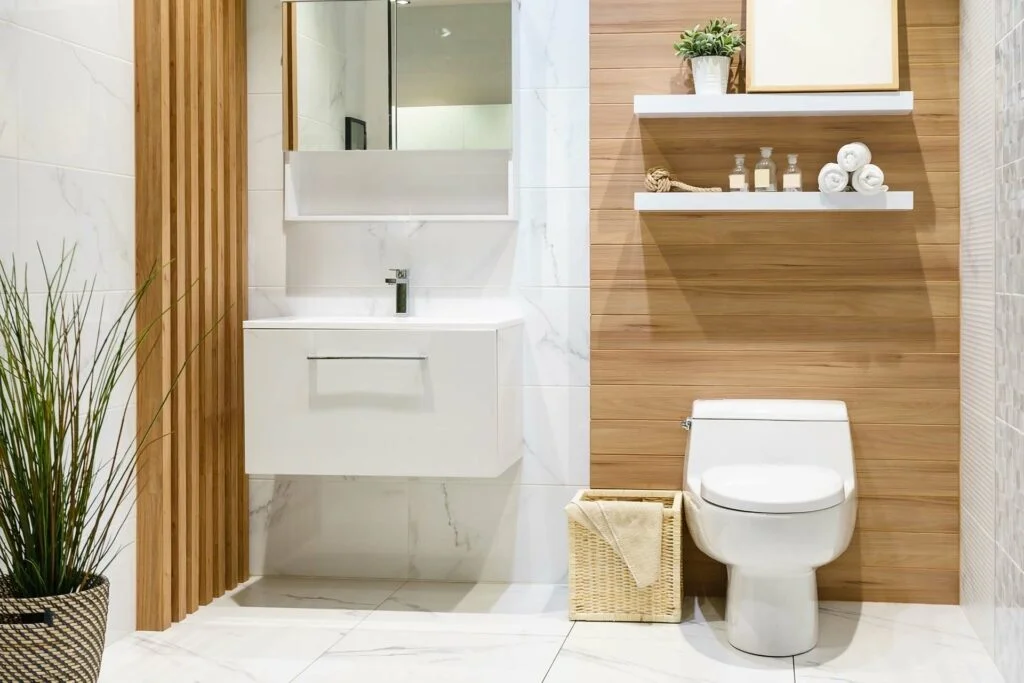
Sleek Bathroom Design
If you prefer a sleek, clean look in your bathroom, concealing your plumbing will give you the best result. However, it is important to keep in mind that concealed plumbing may come with some added costs when compared to exposed pipes. Exposed pipes are easier to spot when leaks occur, which makes repairs less expensive. On the other hand, identifying and repairing concealed plumbing requires breaking down a wall to find it.
Understanding Concealed Plumbing
Choosing whether to conceal or expose the plumbing in your bathroom is a key decision for any homeowner. Exposed pipes offer a more elegant look but are vulnerable to damage from freezing and impacts from furniture or kids playing. Concealed pipes, on the other hand, benefit from the protection of your walls and can therefore be less prone to these issues.
If you choose to keep your exposed pipes, it’s important to plan ahead for maintenance concerns. This is because concealed plumbing can only be accessed by a professional who will need to break down the wall to access the pipes inside. This can be expensive and is not ideal for a home with young children or pets.
However, if you have concealed plumbing and want to hide the pipes in your bathroom, it’s possible to do so with a few simple steps. You can use a variety of creative DIY solutions to cover your pipes and even turn them into an attractive feature in your bathroom.
For example, if you have large vertical pipes running up the wall, you can build a trellis to allow vines to grow along them. Not only will this cover your pipes, but it’ll give you the opportunity to flex your green thumb while hiding them from sight! For a more elegant solution, you can also paint your pipes in different colours.
The Advantages of Concealed Plumbing
If you’re looking for a sleek look with minimal fuss, concealed plumbing is the way to go. It tucks pipes into the wall cavity and leaves the surface of your walls free for decorations, directing attention away from the pipes and their associated fixtures.
On the other hand, exposed pipes have their own unique appeal. The obvious perk here is ease of access, which can prove useful in case of any damage or repair. It’s relatively easy to locate the damaged pipe in exposed plumbing systems, and there are also plenty of DIY solutions available that don’t require breaking apart your walls or calling a plumber to get the job done.
The disadvantage of exposed pipes is that they are more susceptible to damage caused by weather, dust, and general wear and tear over time. Since they don’t have a layer of concrete protecting them, these exposed pipes can easily crack and burst, leading to costly damage.
Another major downside of exposed pipes is that they are a hassle to clean. If you need to scrub your walls each month to keep them clean, this extra task on your to-do list may come as a surprise.
Installing Concealed Plumbing
A new home build or a refurbishment project requires plumbing and pipework, which can be a real eyesore. There are several ways to hide this piping, but the best solution is to conceal it within the walls themselves. This requires building work and can be costly. It is also more difficult to repair if something goes wrong, as plumbers have to break apart the wall in order to reach the pipes.
One of the reasons why many homeowners opt for concealed plumbing is that it offers a more refined aesthetic than exposed pipes. This is especially true if the pipes are tucked away in an enclosed wall cavity, where they are protected from dust and debris. Depending on your preferences, either option can be a good choice, but it’s important to consider the benefits and drawbacks of each before making a decision.
Exposed pipes can be more vulnerable to damage since they don’t have the layer of concrete that concealing pipes have. They are also at a higher risk of freezing and impact damage if they are exposed to extreme weather conditions. Unlike concealed plumbing, which is installed during construction, exposed pipes can be easily repaired. However, this isn’t always a good idea, as it can lead to water leaks. Exposed pipes also require regular cleaning and maintenance in order to prevent the accumulation of dirt, which can affect their functionality.
Selecting the Right Concealed Plumbing Fixtures
There are various ways of concealing plumbing fixtures. The one that is best suited for your bathroom will depend on the design you are trying to achieve. For example, if you are looking for a modern or minimalist bathroom, a concealed cistern toilet might be suitable. This tucks away the suite’s working parts behind a wall so that only the toilet bowl is visible. This option works well with a pedestal or semi-pedestal basin, too, giving you the look you want while keeping your pipes hidden.
Other options for hiding plumbing include pipework casings and sink skirts. These are available in a variety of materials, including wood and metal, to suit your décor. They can be installed around your pipes to create a seamless finish. They can also be used to protect your pipes from damage and prevent corrosion. This is a practical solution that can also make it easier to clean your bathroom.
Another way to hide pipes is by building a column around them. This can be an attractive feature in your room, especially if it is made from reclaimed timber or recycled material. This can give your bathroom a unique aesthetic while providing storage space for towels or other bathroom essentials. If you are considering this option, consult a professional plumber to ensure it will work with your design and the pipes’ location in your room.